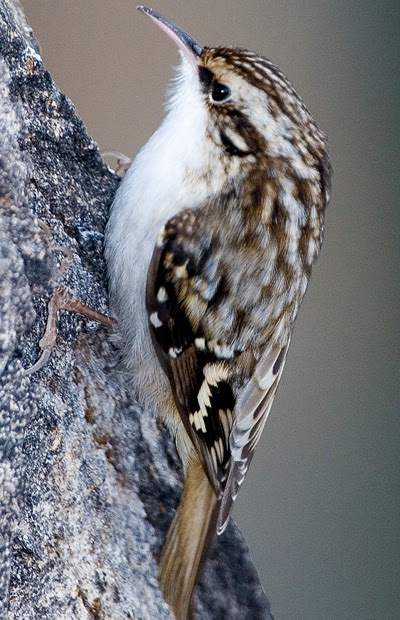Certhia Americana
Order: Passeriformes
Family: Certhiidae
By Sharon L. Moore
Have you ever seen a Brown Creeper? Chances are you’ll answer “no,” but you could be wrong. If you frequent our Northwest forests you’ve likely been near this diminutive bird on a tree trunk and, though it was in plain sight, you missed it due to its stunning camouflage. A tiny, delicate arboreal songbird, the creeper is only 5 inches long with coloring that lets it “disappear” into the trees. The male and female look alike with a white breast and brown back and head speckled with white and black that helps them blend into tree trunks, looking like pieces of bark as they forage. You may see a creeper more clearly as it flies from high in a large tree to the lower trunk of another tree to begin climbing the trunk in search of food.
Unlike other passerines, the Brown Creeper uses it’s rigid tail, as woodpeckers do, to spiral and climb up tree trunks and large branches. While its legs are short, its toes, particularly its hind toes, are long, curved claws. These physical adaptations help it cling to the bark as it feeds, but disallow it from traveling down the trunk, thus it spends its life moving up, not down. On a lucky day you may see a creeper going up a trunk, passing a nuthatch coming down. The creeper’s thin, decurved bill also helps it forage as it stays close to the bark, leaning in to peer into holes and crevices. Invertebrates and their larvae comprise the creeper’s diet including fruit flies, moths, ants, beetles and small spiders. Since the bird may be quite exposed as it forages, its ability to “freeze” helps protect it from perceived threats.
Brown Creepers are a wide-ranging species, living throughout the U.S., Canada and in smaller populations in Mexico. They prefer dense, mature coniferous or mixed coniferous-deciduous forests with large, live trees that provide plenty of shade and humidity. These include Douglas fir, ponderosa pine, spruce and redwood. In the West they may breed in the mountains as high as the tree line at 11,000 feet. Generally foraging in deep forests, these birds often migrate in winter closer to populated areas, roosting communally and foraging in flocks with other species. They may visit your feeders in winter if you include suet, peanut butter or sunflower seeds. Currently there is at least one creeper nest in the mixed conifer-hardwood LBA woods in Olympia. You may also see Brown Creepers in the woods of the Billy Frank, Jr. Nisqually Wildlife Refuge.
Early in the spring breeding season the male and female bonded pair search intensely for a prime nesting site. Ideally, it will be dense forest in a dead or dying tree, specifically a hidden spot between the trunk and a loose piece of bark. The more hidden the nest, the greater the likelihood their chicks will survive. Once the pair agrees on a building site, the female begins to construct the nest. The male helps by bringing her nesting materials and singing nearby, defending their established territory of from 5 to 15 acres. His high, thin vocalizations carry well through the woods and have been likened to the sounds of “ trees, beautiful trees.” He and the female use variations of this call during flight, courtship, chasing and feeding.
The female begins the building process of from one week to one month by layering twigs and strips of bark to form the round nest frame. She then sticks spider egg cases and insect cocoons together to form the inner surface of the nest. Finally, when she finishes lining the nest with leaf pieces, feathers, hair, wood fiber, grass, mosses and lichens, the female is ready to welcome a new family. After laying a clutch of 5 to 6 small, brown-speckled, half-inch eggs, she will incubate them for 13 to 17 days. Danger from predators is high at this point, with the eggs and soon-to-be hatched nestlings vulnerable to being taken by wood rats and deer mice. Chipmunks and jays will also predate if they’re not run off by mobs of creepers, nuthatches and kinglets trying desperately to defend their nests. Adult creepers and other passerines are also in danger of being killed by domestic cats and Northern Shrikes. Once the chicks hatch, they remain in the nest for up to 20 days, fed by both parents. The male and female pair generally stays together for several weeks after the young fledge and leave home. Global Brown Creeper population statistics indicate the species populations have been stable or actually increased slightly from 1966 to 2015. In the West, however, with continuing clear-cutting and selective logging, significant forests where creepers need to forage are being fragmented. Also, salvage logging is removing high numbers of dead and dying trees which creepers need for nesting. As to increasing global warming, spring heat waves endanger young birds in the nest. Even more foreboding is that higher temperatures are beginning to endanger mature trees in our dense forests – the specific habitat Brown Creepers must have to survive as a species.








